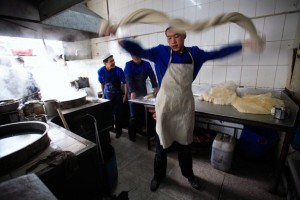By AMY QIN AUGUST 5, 2014 6:00 PMAugust 6, 2014 3:38 pm 2 Comments

A noodle maker shows off his skills in a pulled noodle restaurant in Lanzhou.Credit The New York Times
While the legend that Marco Polo introduced pasta to Italy from China in the 13th century has become one of the most debunked myths of our time, the origins of pasta, known elsewhere as noodles, have for years eluded historians.

Jen Lin-Liu.Credit Lucy Cavender
Undeterred by past failed attempts, the Chinese-American writer and chef Jen Lin-Liu set out on a journey along the ancient Silk Road to trace the origins of the noodle. Ms. Lin-Liu documented her adventures in her book “On the Noodle Road: From Beijing to Rome, with Love and Pasta,” which has just come out in paperback. Part memoir, part travelogue, part cultural history and part recipe collection, the book begins in Beijing, where Ms. Lin-Liu visits what the Chinese claim to be the world’s oldest noodle fragment, and then proceeds westward, into the kitchens of western China, Kyrgyzstan, Uzbekistan, Turkmenistan, Iran, Turkey and finally Italy.
In an interview, she discussed the importance of noodles to the Chinese culinary tradition, what she learned from the people she met on her journey, and healthy eating in a China beset by food safety scandals. Excerpts follow:
Q.
You set out on your journey looking for noodles, but ended up also encountering variations of other Chinese staple foods, such as rice and dumplings. Did these foods really travel along the Silk Road?
A.
Yes, I definitely saw evidence that these foods had been passed across cultures in various regions. One vivid example of this was with hand-pulled noodles, called lamian. From my research and through my travels, I saw that the dish was really at its most refined in northwestern China and is said to have been invented by Muslim Chinese. But the dish could also be found farther west in Xinjiang and Central Asia, regions where it is called laghman. My research seemed to point to the Uighurs, a Turkic ethnic minority that live in China and Central Asia, as a group of people who brought the dish farther west, as they are often middlemen and travelers between the two regions.
